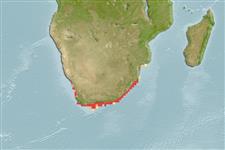Environment: milieu / climate zone / depth range / distribution range
Ekologi
laut dasar (demersal); kisaran kedalaman 59 - ? m (Ref. 57178). Tropical; 22°S - 36°S, 17°E - 36°E (Ref. 57362)
Southeast Atlantic and Western Indian Ocean: Angola round the Cape to Delagoa Bay, Mozambique.
Size / Weight / umur
Maturity: Lm ? range ? - ? cm
Max length : 17.0 cm TL jantan/; (Ref. 5465)
deskripsi pendek
Morfologi | Morfometrik
Duri punggung (Keseluruhan (total)): 0; duri punggung lunak (Keseluruhan (total)): 49-54; Duri dubur 0; Sirip dubur lunak: 24 - 27. Bluish or greenish above, more or less silvery; silver lateral stripe (Ref. 5465).
Inhabits shallow coastal waters, mainly on sandy bottoms (Ref. 27121).
Life cycle and mating behavior
Kematangan | Reproduksi, perkembang biakan | Pemijahan | telur-telur | Fecundity | Larva
Heemstra, P.C., 1986. Ammodytidae. p. 769-770. In M.M. Smith and P.C. Heemstra (eds.) Smiths' sea fishes. Springer-Verlag, Berlin. (Ref. 5465)
Status IUCN Red List (Ref. 130435)
ancaman kepada manusia
Harmless
penggunaan manusia
Perikanan: nilai komersial kecil
informasi lanjut
Umur / SaizPertumbuhanpanjang-beratpanjang-panjangukuran frekuensiMorfometrikMorfologiLarvaDinamika larvapemulihanKelimpahanBRUVS
AcuanBudidaya airprofil budidaya airStrainGenetikaElectrophoresesDiturunkanPenyakit-penyakitPengolahanNutrientsMass conversion
mitraGambarStamps, Coins Misc.Suara-suaraCiguateraKecepatanTipe renangArea insangOtolithsOtakPenglihatan / visi
Alat, peralatan
laporan khas
muat turun XML
Sumber internet
Estimates based on models
Preferred temperature (Ref.
123201): 14.8 - 21.8, mean 16.5 °C (based on 8 cells).
Phylogenetic diversity index (Ref.
82804): PD
50 = 0.6250 [Uniqueness, from 0.5 = low to 2.0 = high].
Bayesian length-weight: a=0.00324 (0.00148 - 0.00706), b=3.10 (2.91 - 3.29), in cm total length, based on LWR estimates for this (Sub)family-body shape (Ref.
93245).
Trophic level (Ref.
69278): 3.1 ±0.4 se; based on size and trophs of closest relatives
Daya lenting (Ref.
120179): Tinggi, Waktu penggandaan populasi minimum kurang dari 15 bulan (Preliminary K or Fecundity.).
Fishing Vulnerability (Ref.
59153): Low vulnerability (10 of 100).
